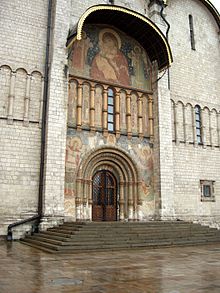
Back Korunovace ruských panovníků Czech Krönung der russischen Zaren und Kaiser German रूसी सम्राट का राज्याभिषेक Hindi Incoronazione del monarca russo Italian Венчание на царство Russian Коронація в Російській імперії Ukrainian

The coronation of the emperor of Russia (generally referred to as the Tsar) from 1547 to 1917, was a highly developed religious ceremony in which they are crowned and invested with regalia, then anointed with chrism and formally blessed by the church to commence his reign. Although rulers of Muscovy had been crowned prior to the reign of Ivan III, their coronation rituals assumed overt Byzantine overtones as the result of the influence of Ivan's wife Sophia Paleologue, and the imperial ambitions of his grandson, Ivan the Terrible.[1] The modern coronation, introducing "Western European-style" elements, replaced the previous "crowning" ceremony and was first used for Catherine I in 1724.[2][3] Since tsarist Russia claimed to be the "Third Rome" and the replacement of Byzantium as the true Christian state,[4] the Russian rite was designed to link its rulers and prerogatives to those of the so-called "Second Rome" (Constantinople).[5]
While months or even years could pass between the initial accession of the sovereign and the performance of this ritual, church policy held that the monarch must be anointed and crowned according to the Orthodox rite to have a successful tenure.[6] As the church and state were essentially one in Imperial Russia, this service invested the Tsars with political legitimacy; however, this was not its only intent. It was equally perceived as conferring a genuine spiritual benefit that mystically wedded sovereign to subjects, bestowing divine authority upon the new ruler. As such, it was similar in purpose to other European coronation ceremonies from the medieval era.
Even when the imperial capital was located at St. Petersburg (1713–1728, 1732–1917), Russian coronations were always held in Moscow at the Cathedral of the Dormition in the Kremlin. The last coronation service in Russia was held on 26 May 1896 for Nicholas II and his wife Alexandra Feodorovna, who would be the final Tsar and Tsaritsa of Russia. The Russian Imperial regalia survived the subsequent Russian Revolution and the Communist period, and are currently on exhibit in a museum at the Kremlin Armoury.
Starting with the reign of Ivan IV, the ruler of Russia was known as "Tsar" rather than "Grand Prince"; "Tsar" being a Slavonic equivalent to the Latin term "Caesar". This continued until 1721, during the reign of Peter I, when the title was formally changed to Imperator (Emperor). Peter's decision reflected the difficulties other European monarchs had in deciding whether to recognize the Russian ruler as an emperor or a mere king, and reflected his insistence on being seen as the former.[7] However, the term "Tsar" remained the popular title for the Russian ruler despite the formal change of style, thus this article utilizes that term, rather than "Emperor".


- ^ Muscovy, Sections "The Evolution of the Russian Aristocracy" and "Ivan IV". For crownings of earlier rulers of Muscovy, see Alfred Rambaugh Rambaud on the Rise of the Grand Princes of Moscow Archived 2012-02-06 at the Wayback Machine.
- ^ Scenarios of Power. Princeton University Press.
- ^ "Museums of the Moscow Kremlin: ASSUMPTION CATHEDRAL".
- ^ Moscow the Third Rome[full citation needed]. See also Moscow Becomes the Third Rome.
- ^ Wortman, pg. 10. A political theory prevalent amongst many Orthodox Russians into the twentieth century postulated that there were three "Romes": the first (Rome) had allegedly apostatized from true Christianity after the Great Schism of 1054 between Roman Catholicism and Eastern Orthodoxy; the second (Constantinople) had equally apostatized by accepting Roman Catholicism at the Council of Florence and had subsequently fallen to the Turks; Moscow and "Holy Russia" were the third Rome, and (according to this doctrine) "a fourth there shall never be". A History of Russia, Chapter 1: Medieval Russia, Section "Ivan the Great".
- ^ New York Times, May 31, 1896. Quoted in Wortman, Introduction. See also Blech, Annalise, The Russian Orthodox Church: History and Influence Archived 2012-10-18 at the Wayback Machine, University of Texas at Austin, 2008, pg. 9.
- ^ Francois Veldi, The Title of Emperor, section "Russia". See also Chancery of the Committee of Ministers, St. Petersburg: Statesman's Handbook for Russia: 1896, Section "On the Prerogatives of the Sovereign Power".